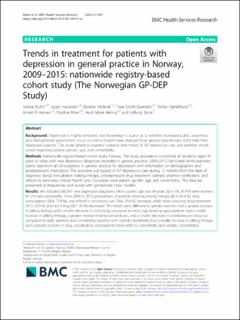| dc.description.abstract | Background
Depression is highly prevalent, but knowledge is scarce as to whether increased public awareness and strengthened government focus on mental health have changed how general practitioners (GPs) help their depressed patients. This study aimed to examine national time trends in GP depression care and whether trends varied regarding patient gender, age, and comorbidity.
Methods
Nationwide registry-based cohort study, Norway. The study population comprised all residents aged 20 years or older with new depression diagnoses recorded in general practice, 2009–2015. We linked reimbursement claims data from all consultations in general practice for depression with information on demographics and antidepressant medication. The outcome was type(s) of GP depression care during 12 months from the date of diagnosis: (long) consultation, talking therapy, antidepressant drug treatment, sickness absence certification, and referral to secondary mental health care. Covariates were patient gender, age, and comorbidity. The data are presented as frequencies and tested with generalized linear models.
Results
We included 365,947 new depression diagnoses. Mean patient age was 44 years (SD = 16), 61.9 % were women, 41.2 % had comorbidity. From 2009 to 2015, proportions of patients receiving talking therapy (42.3–63.4 %), long consultations (56.4–71.8 %), and referral to secondary care (16.6–21.6 %) increased, while those receiving drug treatment (31.3–25.9 %) and sick-listing (58.1–50 %) decreased. The trends were different for gender (women had a greater increase in talking therapy and a smaller decrease in sick-listing, compared to men), age (working-aged patients had a smaller increase in talking therapy, a greater increase in long consultations, and a smaller decrease in antidepressant drug use, compared to older patients) and comorbidity (patients with mental comorbidity had a smaller increase in talking therapy and a greater increase in long consultations, compared to those with no comorbidity and somatic comorbidity).
Conclusions
The observed time trends in GP depression care towards increased provision of psychological treatment and less drug treatment and sick-listing were in the desired direction according to Norwegian health care policy. However, the large and persistent differences in treatment rates between working-aged and older patients needs further investigation. | en_US |

